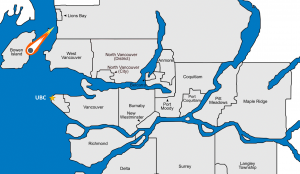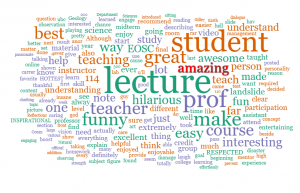During my teaching practicum I wanted to achieve the following goals:
- Teach a large class
- Improve the class activity
- To improve my class management skills
I decided to teach a large class as most of my teaching experience comes from teaching small classes (30-40 people), so that is why I chose to teach an EOSC 114 class with ~260 students. I also chose this class as I am unfamiliar with subject material, thus during my class preparation I would need to work both the PCK and PK aspects of my teaching.
I also wanted to gain more experience in designing and improving various activities for teaching, as I am going need this experience during my CATL project. During the class, I was responsible for teaching part of the lecture ( 2 lectures, morning and evening classes) where students are doing a worksheet exploring the effect of the meteor impact on the Vancouver area. The way the worksheet was originally designed is that students enter the provided parameters into the meteor impact simulator ( a website that calculates the effect based on the input parameters) and explore how it affects the magnitude of the impact ( i.e. building, earthquake strength and etc). However, I found this set up is a little bit disengaging for students as they just follow the instruction without going through the KOLB cycle.

Thus, I created a worksheet consisting of two parts:
- Part students get familiar with how to use a simulator and where to extract the data for their further work. I played around with various parameter settings and came up with the set of parameters that produce the meteor with various impacts (i.e. large earthquakes, huge thermal radiation that will result in ignition of paper, the collapse of poorly structured buildings and many others for students to explore). Although the initial conditions were fixed, I let the students decide themselves what kind of data they want to record (e.g., I asked them to choose the events that are the most dangerous or something that students find interesting). Thus, students did not just copy the results of the simulation but filter the information obtained through the website and use the judgment whether something was worth recording or not.
- Once the students were familiar with how using the settings, I asked them to design their own experiment where they can explore how a change in one input parameter will affect the impact on Earth. Students were free to choose what parameter to change (meteor diameter, an angle of collision with Earth, density or velocity of the meteor) and to explore the changes. I also constructed the worksheet in a similar way they would write their lab reports: starting with the objective, then the table where they record their input parameters and decide what they change and what things they will observe, then a place to record their observations and lastly a small conclusion of their experiment.
I found this activity to go quite well, students seemed to be very interested in the topic and were experimenting with various setup. I also asked students to work in groups of 2-3 people that also make the activity more engaging for students.
The highlight of this activity for me was a bit unexpected but in a good way. While designing the worksheet I was trying to find parameters that will result in the generation of tsunami, but I could not find any to achieve even a small one. After reading certain posts/documentation to the program, I found that those features were not yet available. However, during the class, one group find the optimal parameters to generate a tsunami and students were very excited to achieve smth that I thought was impossible. I think that this was one of the best outcomes from my classroom where students exceeded the expectation and even did a better job at exploring than their instructor.
During my first teaching practicum, I found myself to be extremely nervous, even though I was teaching a smaller class. However, while I was teaching this course I found myself to be more relax and more confident in what I was doing. I did not have a problem in answering students question, asking students to share their observations and generally to hold student attention. However, I think I was more confident because I was co-teaching lecture and my mentor who was present in the classroom. that is why for the future, I would like to conduct the whole lesson myself to make sure that I can manage and conduct the whole lesson without the presence of any senior instructors in the room.
Some of the identified drawbacks of my teaching
- I found that teaching 50 min class is way harder than teaching a 3hr ones as you need to be very efficient in the way you teach and n the way you structure your lesson
- As a result, the worksheet I created was a bit long and thus requires to be cut in half for future use.

